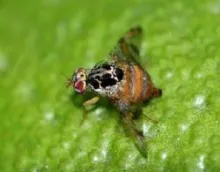|
Publication
|
- Thomas GWC, Dohmen E, Hughes DST, Murali SC, Poelchau M, Glastad K, Anstead CA, Ayoub NA, Batterham P, Bellair M, Binford GJ, Chao H, Chen YH, Childers C, Dinh H, Doddapaneni HV, Duan JJ, Dugan S, Esposito LA, Friedrich M, Garb J, Gasser RB, Goodisman MAD, Gundersen-Rindal DE, Han Y, Handler AM, Hatakeyama M, Hering L, Hunter WB, Ioannidis P, Jayaseelan JC, Kalra D, Khila A, Korhonen PK, Lee CE, Lee SL, Li Y, Lindsey ARI, Mayer G, McGregor AP, McKenna DD, Misof B, Munidasa M, Munoz-Torres M, Muzny DM, Niehuis O, Osuji-Lacy N, Palli SR, Panfilio KA, Pechmann M, Perry T, Peters RS, Poynton HC, Prpic NM, Qu J, Rotenberg D, Schal C, Schoville SD, Scully ED, Skinner E, Sloan DB, Stouthamer R, Strand MR, Szucsich NU, Wijeratne A, Young ND, Zattara EE, Benoit JB, Zdobnov EM, Pfrender ME, Hackett KJ, Werren JH, Worley KC, Gibbs RA, Chipman AD, Waterhouse RM, Bornberg-Bauer E, Hahn MW, Richards S. Gene content evolution in the arthropods. . Genome biology. 2020 01 23; 21(1):15.
- Papanicolaou A, Schetelig MF, Arensburger P, Atkinson PW, Benoit JB, Bourtzis K, Castañera P, Cavanaugh JP, Chao H, Childers C, Curril I, Dinh H, Doddapaneni H, Dolan A, Dugan S, Friedrich M, Gasperi G, Geib S, Georgakilas G, Gibbs RA, Giers SD, Gomulski LM, González-Guzmán M, Guillem-Amat A, Han Y, Hatzigeorgiou AG, Hernández-Crespo P, Hughes DS, Jones JW, Karagkouni D, Koskinioti P, Lee SL, Malacrida AR, Manni M, Mathiopoulos K, Meccariello A, Munoz-Torres , Murali SC, Murphy TD, Muzny DM, Oberhofer G, Ortego F, Paraskevopoulou MD, Poelchau M, Qu J, Reczko M, Robertson HM, Rosendale AJ, Rosselot AE, Saccone G, Salvemini M, Savini G, Schreiner P, Scolari F, Siciliano P, Sim SB, Tsiamis G, Ureña E, Vlachos IS, Werren JH, Wimmer EA, Worley KC, Zacharopoulou A, Richards S, Handler AM. The whole genome sequence of the Mediterranean fruit fly, Ceratitis capitata (Wiedemann), reveals insights into the biology and adaptive evolution of a highly invasive pest species. . Genome biology. 2016 09 22; 17(1):192.
|
 An official website of the United States government.
An official website of the United States government.

The medfly has been an established lab organism for several decades, and is notable as being the closest non-drosophilid relative to Drosophila subject to genetic analysis, with broad chromosomal syntenic relationships established. It is also one of the most important agricultural pests worldwide due to its broad plant host range throughout tropical and sub-tropical regions.
Genetic studies have been driven by efforts to use genetic manipulation to improve the sterile insect technique which is used to control medfly and several other tephritid species through multi-tactical integrated pest management approaches. It was among the first non-drosophilid insects to have a polytene chromosomal genetic map created, having ~30 cloned genes mapped by in situ hybridization. It was also the first to have its germ-line efficiently transformed by a transposon-based vector system. It is now a model system for genetic manipulation in non-drosophilids, including functional genomics analysis, new vector systems for transgene stabilization, genomic targeting, and transgenic strains created for population control.
Data were generated as part of the Baylor College of Medicine's i5k pilot project.
Please cite the following publication when using this dataset:
Papanicolaou, Alexie, et al. "The whole genome sequence of the Mediterranean fruit fly, Ceratitis capitata (Wiedemann), reveals insights into the biology and adaptive evolution of a highly invasive pest species." Genome Biology 17.1 (2016): 192.
Genome update. Previously, the i5k Workspace@NAL hosted Whole genome assembly of Ceratitis capitata, Ceratitis capitata Official Gene Set v1.0, and Functional annotation of Ceratitis capitata OGS v1.0. The assembly and annotations have updated to the most recent assembly, Ceratitis capitata genome assembly Ccap_2.1 (GCF_000347755.3) (https://www.ncbi.nlm.nih.gov/datasets/genome/GCF_000347755.3/), Ceratitis capitata annotations OGSv1.1 (https://i5k.nal.usda.gov/data/Arthropoda/cercap-%28Ceratitis_capitata%29/Ccap_2.1/2.Official%20or%20Primary%20Gene%20Set/cercap_OGSv1.1/), NCBI Ceratitis capitata Annotation Release 103 (https://www.ncbi.nlm.nih.gov/refseq/annotation_euk/Ceratitis_capitata/103/), and Functional annotation of NCBI Ceratitis capitata Annotation Release 103 (https://i5k.nal.usda.gov/data/Arthropoda/cercap-%28Ceratitis_capitata%29/Ccap_2.1/3.Additional%20Gene%20Sets%20and%20Annotation%20Projects/NCBI%20Ceratitis%20capitata%20Annotation%20Release%20103%20functional%20annotation/).